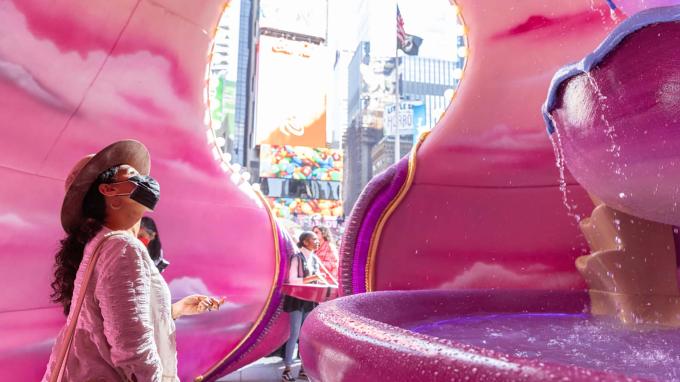
Photo by Michael Hull, courtesy of Times Square Management District.

Photo by Michael Hull, courtesy of Times Square Management District.
Times Square Arts presented Pamela Council's A Fountain for Survivors, a cocoon-like structure adorned with 400,000 acrylic fingernails and housing a fountain, in the fall of 2021.
The cultural landscape of New York City has changed dramatically since March 2020. Creative workers have been disproportionately impacted by the COVID-19 pandemic. The closures of arts venues, cancellations of in-person events, and continued uncertainty around reopening have resulted in unprecedented financial burdens on artists. According to an Americans for the Arts survey, 95 percent of arts workers nationwide had reported income losses and 62 percent had become fully unemployed at the height of the pandemic. Many of the city’s cultural institutions have faced major revenue losses, increased operating and capital expenses, staff furloughs and layoffs, and persistent questions about audience return.
The pandemic also laid bare the many injustices baked into the city’s cultural system. Mainstream cultural institutions are predominantly white-led and lack diversity among staff, allowing cultural bias, prejudice, and racism to prevail. While exacerbated by the pandemic, these inequities were prevalent before 2020 and will persist after recovery if the city’s cultural leaders and funders do not focus on long-term, systemic change.
Artists have played an important healing and uplifting role during this time of crisis. They have elevated their voices in the struggle for racial and social justice and on issues impacting their communities, often in partnership with other civic actors and movements in the cultural field. Frustrated by both the country’s and the field’s responses to systemic racism and resulting disproportionate impacts of the pandemic, new arts advocacy groups are advancing diversity, equity, inclusion, and accessibility (DEIA) in the artistic community.
Leaders at many of the city’s iconic museums and cultural institutions are also working to implement DEIA plans to break down barriers and create opportunities for underrepresented artists and audiences. Community-led cultural organizations—which have been at the forefront of support for artists of color, LGBTQ+ artists, and artists from other underrepresented groups—are finally being recognized for their leadership in advancing the rich cultural life in their neighborhoods and the artistic vitality of New York City.
RBF trustees and staff acknowledge our own moral obligation to address past and current injustices that harm socially, politically, and economically marginalized groups. In 2020, the board approved an updated commitment to diversity, equity, and inclusion and directed new resources to racial justice efforts. The Culpeper Arts & Culture program has championed diversity and support for under-represented and under-resourced artists and communities from the outset.
The relationships between the arts and the Fund’s other grantmaking themes are also increasingly visible: Artists and arts organizations focus on broad issues like strengthening democratic values, advancing sustainable development, and securing just peace and make important contributions to cross-cutting racial justice issues. With an emphasis on participation, innovation, and diversity, the arts offer an alternative to dominant exclusionary narratives that can shift the paradigm.
The Fund itself is also changing. Residencies and presentations at The Pocantico Center have been an integral part of the Fund’s arts and culture grantmaking. In 2022, we will open the new David Rockefeller Creative Arts Center to add significant new performance, rehearsal, studio, and gallery space. The addition of the DR Center will create new collaborative programming opportunities for the Culpeper program and Pocantico, including a new visual artist residency, a community arts residency, and an exhibition program.
As the Rockefeller Brothers looks to 2022 and beyond, we recognize the need for changes to our arts and culture grantmaking to respond to a post-pandemic world. The long impacts of the COVID-19 pandemic signal that cultural and philanthropic leaders must do better in creating long-term stability for the artists best positioned to inspire the revitalization of more equitable and just New York City.
In November 2021, the Board of Trustees approved modest revisions to the Culpeper Arts & Culture program guidelines that take into account this changing context. With a sustained focus on the creative process, these new guidelines emphasize community building and social impact, prioritize artist-centered and multidisciplinary work, advances the Fund’s anti-racist and anti-sexist commitments, ensure attention to accessibility, and celebrate innovation and artistic excellence. They expand artistic residency support, both at Pocantico and other cultural institutions in and around New York City. They also focus the scope of the Fund's capacity-building grants to support compelling field research, advocacy efforts, and leadership development during this critical moment for New York City’s artistic community.
The COVID-19 pandemic unveiled, intensified, and accelerated challenges and trends in the arts sector that existed long before 2020. The new guidelines will help us maximize the impact of our grantmaking for New York City’s creative community to contribute to a more just, sustainable, and peaceful world.